And again crowdfunding: today in American

Recently, the topic of crowdfunding quite often rises to Habré, there have been posts as encouraging common perspectives of the “people's folds”:
March 18, 2012 / Fans have already collected $ 1.3M on Wasteland 2 / fixer_m
April 13, 2012 / Crowdfunding market has tripled in 2011 / ilya42
So rather pessimistic, based on the practical application of crowdfunding in Russia:
')
April 17, 2012 / The results of a whole year of donations delivered to a journalist via the Internet are announced / Mithgol
April 5, 2012 / Charities (sponsorship) and stock (crowdfunding): two different forms of financing font development
By the way, the comments seemed to me even more pessimistic, both in relation to the use of crowdfunding in Russia, and in the general feasibility of this method.
But today I want to talk about one of the pioneers of crowdfunding - Kickstarter. About what they expected at the very beginning of the project and what, in the end, turned out. A kind startup diary with a large number of numbers and graphs showing the overall dynamics of the development of the service.
How did kickstater begin
Kickstater was launched on April 28, 2009 with two projects created by the founders themselves and a loud statement: "Kickstarter is a new way of financing that breaks the traditional methods - loans, investments and grants."
The model is quite simple: the author of the project assigns the necessary amount for implementation, time to collect the amount and reward users who supported it with money. If the required amount is collected for the specified time (project duration), all users who have expressed a desire to support the project are reset using Amazon Payments, and then receive their rewards. If the project could not collect the required amount - no one is reset.
Since Kickstarter was one of the first services using the crowdfunding model, the forecasts of the main indicators were made very carefully, with notes of pessimism. So it was assumed that the number of projects that collected the necessary amount of money will be about 5% of the total number of projects.
Startup diary
“In principle, without departing from the cash register, it can be assumed that crowd funding will be distributed according to Zipf (according to the 80/20 rule) - 20% of the most popular projects will receive funding (the top 1% will receive several times more than necessary), and the remaining 80% are not. ”- from the comments on the article“ The results of a whole year of reading donations received by the journalist via the Internet are published ”.
Having initially laid low scores for key performance indicators, both for the service and for the crowdfunding itself, the start-up has begun to work.
Day 86
Three months later, on July 24, 2009, the team published the first interesting observation in their blog: if the project gets donations for 25% of the required amount, then the chance of successful financing of the project rises to 94%. And clearly illustrated this conclusion on the chart:
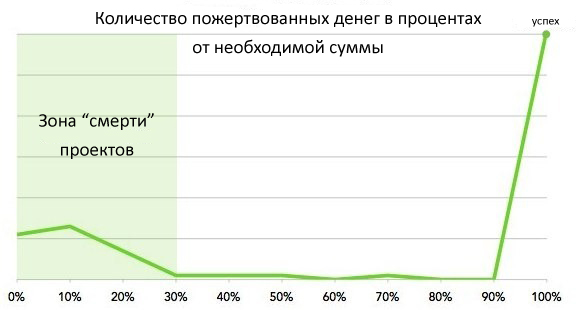
On the X axis - How much the project has collected donations in relation to the required amount.
Y-axis - How many projects have reached this level.
(unfortunately, on the original graph there is no scale on the Y axis)
The Kickstarter team was pleasantly surprised by the low threshold of the “death” zone of the projects and suggested that this was due to the “fans” of the projects - they do not allow projects to die, attracting new people and actively campaigning and spreading information about the project they like on social networks, blogs and In general, wherever possible.
Then there was a lull, Kickstarter was developing, more and more projects were being created on it, but the founders were not in a hurry to share information about how the crowdfunding model still works on the network.
Day 510th
And now, after a long 510 days have passed since the start of the service, on September 21, 2010, Kickstarter published the next statistical data. They are still quite scarce and are aimed mainly at the authors of future service projects, but from this they are no less interesting.
A small digression: over time, the concept of “reward for supporting a project with money” has expanded a little, now the project authors are advised to assign several awards for various amounts of donations. For example, for a donation of $ 5 - a calendar with a funny face of the author of the project, for $ 20 - a t-shirt with the same physiognomy, but for $ 50 or more - a collection of hits "songs from the soul" on the CD with the autograph of the author, while The project was created to raise money for recording these songs in a professional studio.
So, the Kickstarter team analyzed all the successful projects and decided to find a connection between the “cost” of the minimum reward (that is, the amount that needs to be donated to get the most initial reward) and the percentage of people donating to the project.
It turned out that the rewards worth $ 50 collect 11.44% of all donated dollars, and the cost of $ 100 collect the most - 16.36%. The most popular are the rewards for $ 25 - 18.41% of the total number of users preferred them.
However, rewards with low cost (up to $ 25) also make a significant contribution to the development of projects, they together collect 10% of all donated money, but at the same time the number of donations reaches 38% of the total. And the main value of cheap awards is not in the money attracted to the project, but in the received fans who will informationally support the idea that they like and attract new people.
The graphs below illustrate in detail the relationship between the value of awards, the amount of money raised and the number of donations.
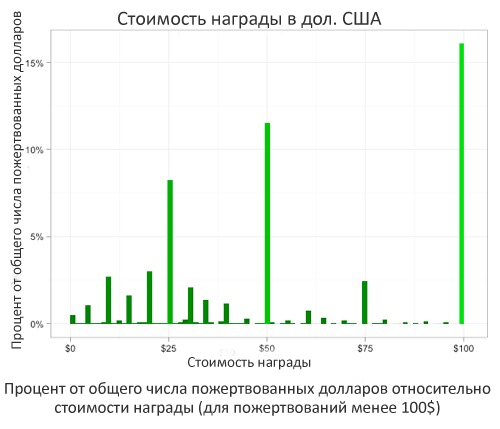
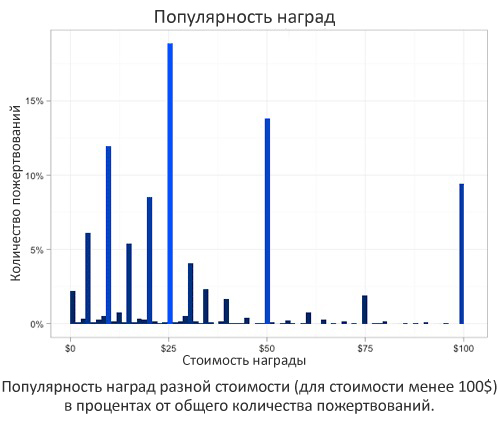
Table of popularity and weight of the total amount of money collected for awards of different value up to $ 1000.
| Minimum reward. | Popularity in% of the number donated. | % of the money collected from the total count. |
|---|---|---|
| $ 25.00 | 18.41% | 8.14% |
| $ 50.00 | 13.57% | 11.44% |
| $ 10.00 | 12.12% | 2.82% |
| $ 100.00 | 9.52% | 16.36% |
| $ 20.00 | 8.41% | 3.01% |
| $ 5.00 | 6.37% | 1.07% |
| $ 15.00 | 5.62% | 1.71% |
| $ 30.00 | 4.22% | 2.20% |
| $ 1.00 | 2.43% | 0.53% |
| $ 35.00 | 2.25% | 1.31% |
| $ 75.00 | 1.94% | 2.51% |
| $ 40.00 | 1.63% | 1.14% |
| $ 250.00 | 1.26% | 5.43% |
| $ 500.00 | 0.99% | 8.46% |
| $ 150.00 | 0.97% | 2.52% |
| $ 200.00 | 0.83% | 2.81% |
| $ 60.00 | 0.73% | 0.74% |
| $ 12.00 | 0.60% | 0.15% |
| $ 1,000.00 | 0.46% | 8.51% |
| $ 45.00 | 0.41% | 0.30% |
| $ 125.00 | 0.32% | 0.76% |
| $ 300.00 | 0.31% | 1.78% |
| $ 65.00 | 0.28% | 0.31% |
| $ 29.00 | 0.26% | 0.13% |
| $ 55.00 | 0.20% | 0.19% |
| $ 80.00 | 0.15% | 0.22% |
| $ 70.00 | 0.13% | 0.18% |
| $ 350.00 | 0.10% | 0.59% |
| $ 101.00 | 0.09% | 0.20% |
| $ 99.00 | 0.09% | 0.15% |
In addition, the Kickstarter team analyzed the duration of projects, and the distribution of the number of donating in time for successful (i.e. collecting the required amount) projects.
It turned out quite an interesting schedule:
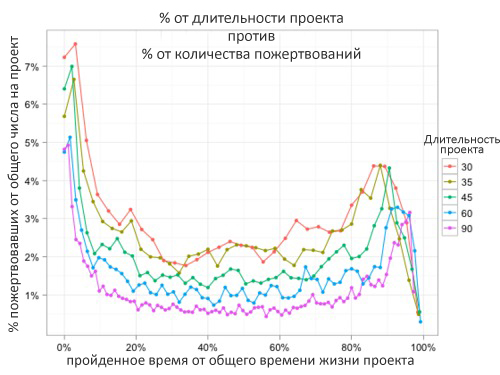
All successful projects were divided into 5 types by duration: 30, 35, 45, 60 and 90 days. It turned out that the same form of the donation distribution curve is typical for all projects: the most interest is in the beginning, in creating the project and in the end before the end of the collection of money. Bursts at other sites appear during the project advertising campaigns in the media, social networks, etc.
In general, Kickstarter has long been looking for the most optimal project duration, so it was decided to evaluate all the projects and find out if there is a relationship between their duration and success.
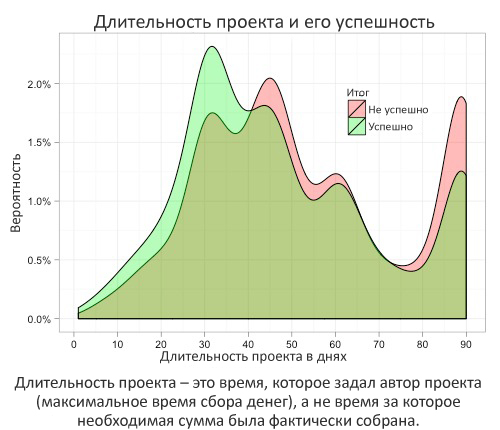
In this graph, the X axis is the duration of the project, and the Y axis is the relative popularity (more precisely, the probability that a successful or unsuccessful project will fall into this space) of this duration.
As can be seen from the graph, the creators of successful projects most often choose the project duration of 30 days, while the authors of unsuccessful projects 45 and 90 days (for Kickstarter, 90 days is the maximum duration of the project). Of course, this does not mean that the chosen project duration will affect the final result, but it definitely tells us something about those who choose such a duration.
Interestingly, the projects lasting 30 days, as a rule, are created by people who are optimistic about their chances, as well as actively involved in promoting their project and attracting new supporters.
On the other hand, people who choose more days are less confident and think that longer duration automatically increases the chances of a project to collect money.
Day 642nd
April 28, 2011, Kickstarter celebrated 2 years and prepared a fairly detailed report for this significant date. So what happened in two years?
Donated dollars per month:

For two years, the number of dollars donated to projects for the month reached $ 7,000,000 and the growth rate of the number of donations is steadily increasing.
Running projects per month:
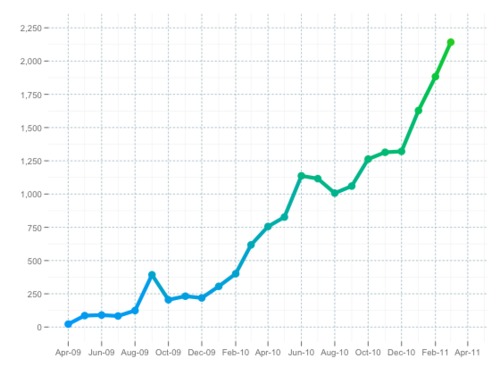
The schedule of running projects per month is similar to the schedule of donated dollars, only in March 2011 more than 2000 projects were created.
And how much money was collected by successful projects?
On April 28, 2011 it was donated: $ 53,107,672, of this money for successful projects (ie projects that collected the required amount) collected about $ 40,000,000, while the failed projects raised only $ 7,000,000. In this case, now in projects, the time of collecting money which did not work out, is about $ 6,000,000.
Those. successful projects collect about 85% of all money, and this figure has been fairly steady over the past two years.

And what is the situation with the projects?
In two years, 20,371 projects were launched, of which 7,496 projects collected the necessary amount and were completed, 9,700 projects failed to raise the required amount, and 3,175 projects still raised money (remember, we are talking about April 28, 2011 ).
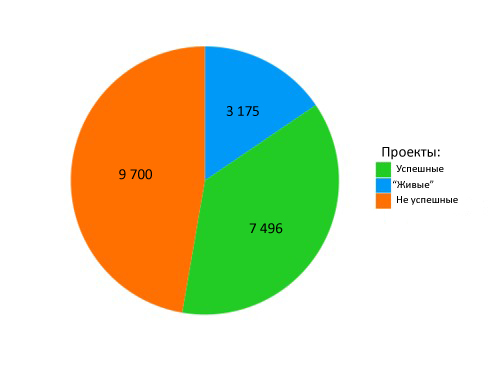
Those. About 43% of the projects successfully collected the necessary amount, and this percentage stably remains at the level of 40-45%. Let me remind you that the Kickstarter team laid in their calculations only 5% of successful projects, well, a very unexpected indicator!
Another feature worth paying attention to is that these 43% of projects collect 85% of all donated money. And from among the unsuccessful projects - 21% failed to collect a single donation.
By the way, it turned out that if at least one person donates to the project, then the chances of this project to collect the entire amount increase to 52%. A project that has reached 30% of the assigned amount has a 90% chance of the success of collecting the entire amount.
More detailed data is shown in the graph:

And what about the projects most collect money?
The most popular categories of projects are films, they collected about $ 20,000,000, as well as music, which was able to collect $ 13,000,000. The Kickstarter team counted 13 different categories of projects, and it turned out that 10 of them were able to collect more than $ 1,000,000.
Table of categories of projects and money raised:
| Category | Collected $ |
|---|---|
| Art | 3,184,732 |
| Comics | 943,118 |
| Dancing | 645,492 |
| Design | 3,601,851 |
| Fashion | 554,048 |
| Films | 19,717,790 |
| Food | 1,583,063 |
| Games | 1,052,557 |
| Music | 13,094,547 |
| The photo | 1,679,361 |
| Publicism | 2,732,501 |
| Technology | 1,748,109 |
| Theater | 2,570,503 |
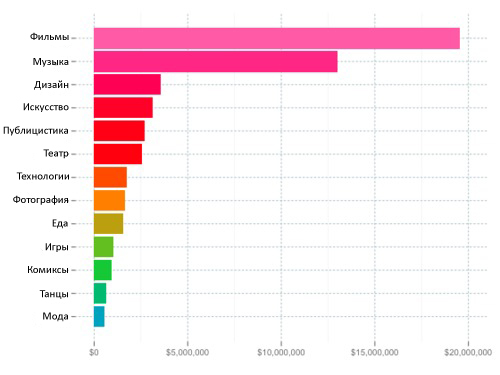
Donating users:
As of April 28, 2011, 591,773 users registered at least once donated to a project. At the same time constantly donating users (ie, donating more than once) - 79,658 people.
Well on this biennial report is over. Well, do you already look at crowdfunding in a different way?
Day 692nd
On June 17, 2011, Kickstarter cut the maximum possible duration of project fundraising from 90 to 60 days. What was the reason?
The fact is that at this date the overall success rate of the projects, i.e. The percentage of projects that collected the necessary money is 44%. And for projects whose duration is 90 days, only 24%, the Kickstarter team decided once again to link the duration of the projects and their success.
In general, 90 days is a very long time, it is difficult to maintain good activity around the project all this time, both the project creators, their supporters and fans get tired.
The graph showing the relationship between the duration and the percentage of successful projects is also interesting:
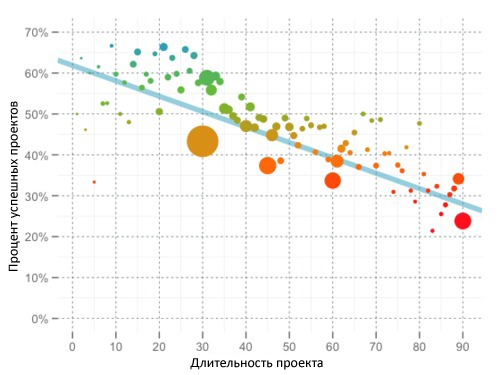
On the X axis - the number of days selected by the author of the project, on the Y axis - what percentage of projects with such a duration were able to collect the required amount.
As you can see, projects that have chosen a longer fundraising period, as a result, collect the entire amount much less often.
The distribution of donations in time:
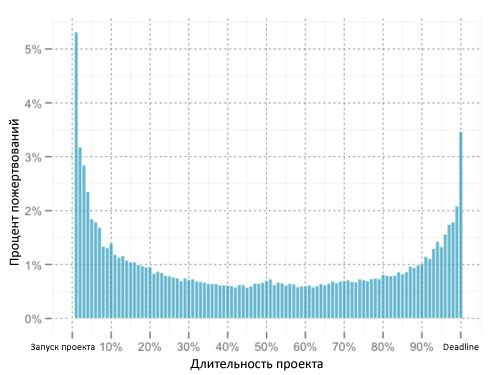
On the X axis, we see how many percent of the total duration of the project has passed, and on the Y axis, what percentage of the total number of donations was donated during this period.
From the graph it is clear that the most donations accounted for the launch of the project and before the end of the collection of donations. This is easy to explain: as soon as the project is launched, the most active project fans tend to donate and tell others about it, but when the donation period is right, those who liked the project wake up, but they wanted to hold the money (before salary, tomorrow I’ll throw off the money and etc.), and now they discover that there will be no other chance.
In the middle, however, there is a decline in activity, it is this decline that needs to be constantly stimulated (through project advertising, project updates, etc.) in order to maintain the level of donations. Accordingly, the longer the fundraising period, the more difficult it is to stimulate activity on it.
Meanwhile, more than 24,000 projects have been launched on the service ...
Day 724th
On July 6, 2011, an anniversary 10,000 project was successfully completed on Kickstarter. In this connection, the statistics on projects was again calculated. Has anything changed?
As of July 17, 2011, 26 620 projects were launched, of which 10 388 were successfully accumulated, but could not collect 13 113. At the same time, 3 119 projects still collect money.
Thus, the percentage of successful projects was 44%.
The number of projects that collected the required amount is constantly increasing, for example, on July 17, 2010 there were only 1,885 successfully collecting the entire amount, and a year later this number increased 5 times.

Fun facts: for the first year of existence of Kickstarter, 1044 projects were financed, exactly the same amount as in July 2011.
What successful projects are being created the most?
Previously, statistics were provided on the categories of projects and the total amount of donations collected by them. And now let's see how many successful projects in each category.
Music and films dominate, 60% of all successfully completed projects fall to their share. From the differences compared with the amount / category schedule, there are some categories that occupy a larger share in the number of projects than in the collected amounts, for example, in the dance category there were more successfully completed projects than in design and technology, but less money was collected .

How much money did successful projects raise?

As expected, most projects collect $ 5,000 or less.
And once again the statistics of donations collected:
In total, $ 75,262,447 was donated, of which about $ 60,000,000 was collected by successful projects and $ 9,000,000 unsuccessful. About $ 6,000,000 was donated to projects that are still collecting money.
In April, Kickstarter crossed the milestone of $ 50,000,000 donations, and after 10 weeks the amount of donations was $ 75,000,000, excellent dynamics!
And how many days do you need to collect $ 5,000,000 donations?
It took 342 days to collect the first $ 5,000,000 donations, with the last time $ 5,000,000 was collected in just 18 days.

On the Y axis, the number of days required to collect $ 5,000,000 donations is postponed, months are postponed on the X axis, and points for collecting the next $ 5,000,000 are highlighted by dots.
Donating users:
As of July 7, 2011, 793,362 donated users were registered. At the same time, 118 308 people donated more than once.
There is a steady growth of constantly donating users, despite the fact that they constitute only 13% of the total number, but at the same time they donated 28% of the total number of donations.
808th day
On October 11, 2011, Kickstarter acquired the 1,000,000th donated user. In honor of such a significant event was presented statistics on users of the service.
New donating users per month:
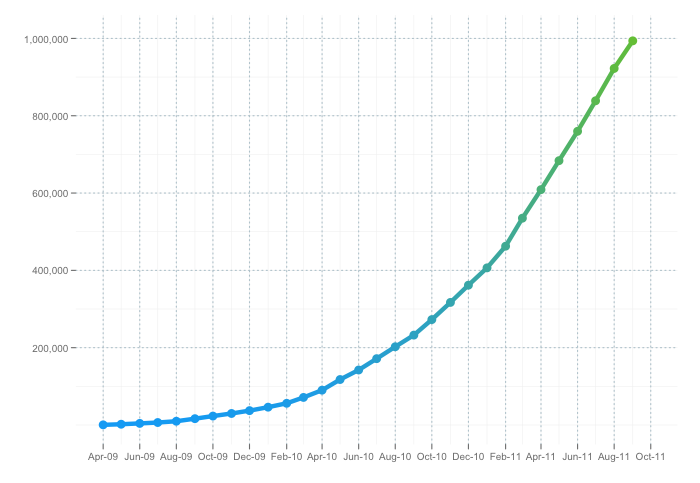
The first 200,000 donating users had to wait 16 months, but the last 200,000 - only 3 months.
In addition, 75,000 users donate to various projects every month.
Other interesting facts:
- 89% of users donated at least once to a successful project, and only 11% never.
- Most of the projects were supported by a certain Neil Graham - he financed 94 projects, of which 83 out of 84 were successful and 10 were not yet completed.
- 16% of users (166,823 people) donated to more than one project, and 84% (1,013,725 people) donated only to one.
- 66,676 users funded 3 or more projects, and 23,601 - five or more.
- users who donated only once collected $ 68,000,000 in total, and those who donated more than once donated $ 32,000,000.
How users donate:

More than 90% of all donations were made with the amount of $ 100 or less, and 75% with the amount of $ 50 or less.
And again the statistics of the collected donations:
On October 11, 2011 donations in the amount of $ 100,729,560 were collected. At the same time, about $ 84,000,000 was collected by successfully completed projects and $ 12,000,000 not completed.
$ 5,000,000 donated to projects that are still collecting money.
Kickstarter has reached a serious mark of $ 100 million in donations, an impressive amount, it can be compared with the budget of the US National Art Council, which in 2011 amounted to $ 154 million.
With the current dynamics of 2,000,000 donations every week, Kickstarter will soon exceed the total amount of donations of 100 million a year.
The funny thing is that the millionth donation was made with a 48-hour lag behind collecting total donations of $ 100,000,000. The average donation amount is $ 71, and the average donating user funds 1.4 projects.
Day 985th
January 9, 2012, Kickstarter summarizes the results of the past 2011. The year was really successful and, one might say, a turning point: in April, Kickstarter celebrated his second birthday and collected donations in the amount of $ 50,000,000.
In July, the 10,000th successfully completed project was celebrated, and in October, the total amount of donations increased to $ 100,000,000 and users donated more than 1,000,000 times.
Let's look at some general indicators achieved for 2011 and compare them with 2010 figures:
| 2010 | 2011 | |
| Projects launched: | 11,130 | 27,086 |
|---|---|---|
| Successful projects: | 3,910 | 11,836 |
| Donated to: | 27 638 318 $ | 99 344 382 $ |
| Donation awards issued by: | 322 526 | 1,150,461 |
| Total website visitors: | 8,294,183 | 30 590 342 |
| Percentage of successful projects: | 43% | 46% |
Project categories:
Statistics of projects divided into categories created in 2011:
| Project Category | Number of projects | The number of donated | Total donations |
| Art | 1,172 | 78,558 | $ 5,916,116.14 |
| Comics | 267 | 27,544 | $ 1,763,628.48 |
| Dancing | 292 | 14 377 | $ 1,054,763.95 |
| Design | 319 | 99 923 | 9 180 637,55 $ |
| Fashion | 182 | 16,793 | $ 1,351,659.85 |
| Films | 3,284 | 308,541 | $ 32,473,790.40 |
| Food | 241 | 30,682 | $ 2,809,503.31 |
| Games | 253 | 45,622 | $ 3,616,530.88 |
| Music | 3,653 | 260 178 | $ 19,801,685.21 |
| The photo | 343 | 26,897 | $ 2,116,261.93 |
| Publicism | 774 | 74 280 | 5 134 388,55 $ |
| Technology | 125 | 39 341 | $ 4,673,470.41 |
| Theater | 931 | 50 144 | 4 051 962,62 $ |
Movies and music still occupy the first place in all respects, but design has grown in the number of projects (235 in 2010 against 1060 in 2011), games can boast an increase in the number of donating users (up to 730%), and dances have the highest percentage project success.
Most Popular Awards:
The most popular awards in 2011 were:
Cosmonaut - stylus cost from $ 1 to $ 50, 5,623 people chose this award.
Coffee Joulies - Inside $ 40 $ Hot Water Heater , 4,246 people chose this award.
Capture Camera Clip - a clip holder for a camera for $ 50, 3,372 people chose this award.
Pen Type-A - pen worth $ 50, 2,930 people chose this award.)
Jot - stylus worth $ 25, 2 556 people chose this award.
PadPivot - a stand for iPad worth $ 25, 2,515 people chose this award.
Users who financed the most projects:
In 2009, the most active user supported 56 projects, in 2010 already 179 projects. In 2011 - 724 projects.
Fun facts: two Kickstarter employees entered the top 10 active users with a score of 326 and 233 funded projects.
The fastest project start:
The coolest start was shown by the project Elevation Dock (stand for iphone), which scored $ 165,910 in just 24 hours.

The coolest finish of the project:
The film Mosquita y Mari was on the verge of failure, by the end of the allotted time, he could not collect 50% of the required amount. But 48 hours before the end of the time to raise funds, users donated $ 35,000. Project saved!

To be continued
At this startup diary stops until the next entry, but does not end there. We will follow what Kickstarter will bring in 2012, what new records it can beat and what new amazing facts will come to light about the crowdfunding model that is well forgotten but radically reborn in the modern world.
I think that this is a very promising model not only for the USA and Europe, but also for our post-Soviet space. We just lack some factors, but to which, of course, we are approaching. And I'm not even talking about the desire to give their money, as shown by some experiments - people willing to give money for what they like and like interestingly, but about the level of sociality, after all, the “fans” who actively promote Kickstarter-loved projects social networks and even offline, exactly make it possible to collect the necessary funds.
And lastly, the list of Russian crowdfunding startups:
| Crowd funding in creativity: financing creative projects (Kickstarter-like) |
| S-Mira-Po-Nitke is a Russian crowdfunding platform, or cloud-based project financing. “Throw off your friends to build a skate park? Composed a new album, but not enough money for a good studio recording? Want to publish a book of poems and send to fans? That way!" Created Date: 2010 Status: fully started. |
| RuStarter - crowdfunding in Russian. “We are pleased to announce that we are preparing to launch RuStarter.ru - a platform aimed at accumulating progressive ideas and projects. Architects, sculptors, writers, journalists, animators, directors, programmers, designers, artists, scientists, engineers - we are waiting for everyone who has a dream, but there are no funds for its realization. Each user of the Internet will be able to evaluate the innovation and help in its implementation. We will bring together investors and authors of great ideas. Russtarter is crowdfunding in Russian. " Date created: 2012 Status: presumably launch in July. |
| Time to Start - the incubator of ideas. “TIME-TO-START is an incubator of ideas in which you can place your project and, making every effort to interest as many people as possible, to raise funds for its implementation. Everyone can tell about their idea, specify the amount that is necessary for its implementation, and the benefits or gifts that will make a contribution to your project. " Created Date: 2010 State: closed. |
| Primary capital is a new way of financing creative projects and small home businesses. “If you need money, or you are ready to invest money - First capital for you! Your idea should be implemented, and not gathering dust on the shelf! We know for sure that there will be people willing to help in the development of the idea! (look at the experience of our American colleagues). Become the owner of unique things and opportunities! Finance in their development and you will not miss anything! ” Date created: 2011 Condition: prepare for opening. |
| Tap to Start - Just tap to start up! “Taptostart is a new, convenient and easy-to-use resource for financing ideas and projects for (for now) Russian-speaking people all over the world. Each registered user can create a project and receive financial support, as well as finance projects of other participants. ” Date created: 2011 Status: closed testing. |
| Naparapet - should be for everyone. “Discussing the protracted dialogue with the first producers-investors of the Chapito Show, we thought, as it would be great, not to prove every time that you are not a camel, do not beg to believe that the viewer will be found, but to immediately make a movie for audience donations. That is, so that potential viewers invest in our new film with small amounts, ... investors? Doesn't this all go? - we thought, and began to invent Naparapet. .» : 2011 . : . |
| Startwithme – , . «Startwithme - , , , .» : 2011 . : . |
| : |
| – , . « dirty.ru, , , , , , .» : 2011 . : . |
| – . «« » — , – , , . (, ). .» : 2011 . : . |
| – . «« » — , .» : 2010 . : . |
| – . « — , . ? , 10 . , , . , .» : 2012 . : . |
| . – 100 . « - «.» - (, , ).» : 2005 . : . |
| : |
| Kroogi – . « – , , , , , , . , , «, ».» : 2008 . : . |
| ThankYou.ru – , . « , — . , .» : 2010 . : . |
| Planeta.ru – . « , , . , .» : 2012 . : . |
| : |
| – , . « . 8 . . — 1,7 . . , , 7,5 . .» : 2011 . : . |
| IT: |
| IT RockOut – . « , , Drupal, Android, flash , — . , , , , , .» : 2012 . : . |
| : |
| YouMax – . « . . .» : 2008 . : . |
, , «» .
Kickstarter.
, - !
PS:
, .
? , .
Source: https://habr.com/ru/post/143353/
All Articles